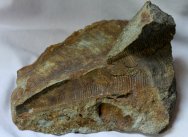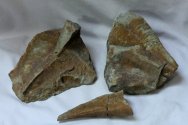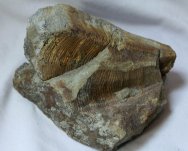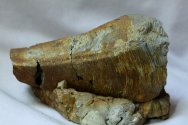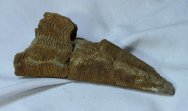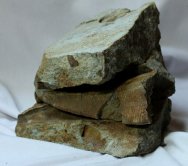Paraconularia
derwentensis
Phylum
Cnidaria (?), Conulariidae
Geological
Time: Early to Middle Permian
Size (25.4
mm = 1 inch): Fossils are 130 mm by 45 mm by 60 mm and 110 mm by 35
mm by 45 mm Assembled Matrix: 120 mm by 120 mm by 130 mm
Fossil Site:
Dabool Sandstone, Woodbridge Group, Poatina, Great Western Tiers, Tasmania,
Australia
Code: AAF481
Price: Sold
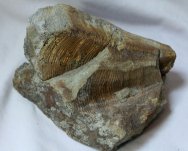 Description:
Conulariids have been a subject of speculation for over a century
and a half. They ranged from the Middle Ordovician to the Triassic.
Exactly what they were is still not settled. Because of their
fourfold symmetry, they have often been placed in the Cnidaria.
However, their skeleton was very different from anything known
in the Cnidaria, and they may represent a separate, extinct phylum
The Conulariids had elongated, pyramidal exoskeletons, made up
of rows of calcium phosphate rods. Most were square or rectangular
in cross section, with prominent grooves at the corners. They
lived attached to hard objects by a flexible stalk, and often
lived in groups. They are thought to have been filter feeders;
how they reproduced is not known. This is the largest example
I have come across, quite 3-D in aspect. It cracked into several
parts upon splitting, but you can clearly see the unusual structure. Description:
Conulariids have been a subject of speculation for over a century
and a half. They ranged from the Middle Ordovician to the Triassic.
Exactly what they were is still not settled. Because of their
fourfold symmetry, they have often been placed in the Cnidaria.
However, their skeleton was very different from anything known
in the Cnidaria, and they may represent a separate, extinct phylum
The Conulariids had elongated, pyramidal exoskeletons, made up
of rows of calcium phosphate rods. Most were square or rectangular
in cross section, with prominent grooves at the corners. They
lived attached to hard objects by a flexible stalk, and often
lived in groups. They are thought to have been filter feeders;
how they reproduced is not known. This is the largest example
I have come across, quite 3-D in aspect. It cracked into several
parts upon splitting, but you can clearly see the unusual structure.
|
|

